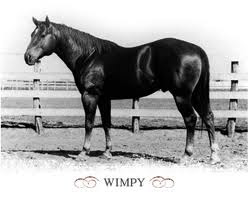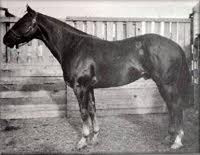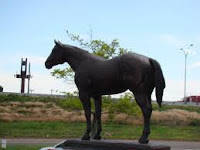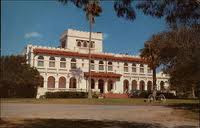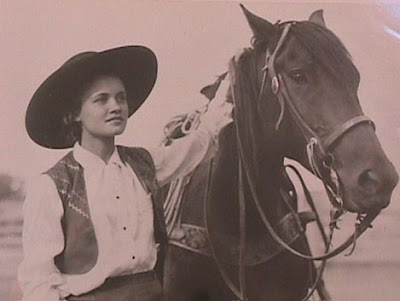The King Ranch is known for its own specific breed of cattle called the Santa Gertrudis. These cattle were officially recognized as a breed in 1940 by the United States Department of Agriculture as an authentic and distinct breed of cattle (Akerman). Bred on the King Ranch by the Kleberg family, Kleberg was looking to raise superior beef cattle that could resist insect pests, disease and plagues, and feed off of land with recurrent drought while keeping a weigh suitable for market. The English Shorthorn cattle could not withstand such conditions, for example, the sun caused them to run a temperature that would effect their grazing, this could not make the profit needed to keep the ranch alive.
A neighboring rancher, Thomas M. O'Connor, gave the King Ranch a half-Brahman, half-shorthorn bull. It had jumped in with the herd of shorthorn heifers, and one of the offspring from this incident proved to be successful in such conditions of southern Texas. Robert Kleberg found great interest in this mishap and continued with furthering the blood lines to achieve the ideal breed.The Kleburgs imported Brahma cattle from India to develop the satisfactory breed for their ranch In 1919 Kleberg mated a Brahman bull, Vinotero, obtained from A.P. Borden, with a blood-red Shorthorn cow of one-sixteenth Brahman cattle blood, a descendant of the original O'Connor bull (Akerman). The offspring from this combination proved to be the Santa Gertrudis breed the ranch was looking for. The genetics turned out being three-eighths Brahman and five-eigths Shorthorn blood, their color includes a solid cherry-red with only mirror markings on the underline, and may be horned or polled (Akerman). As for branding these cattle the Running W appeared in the 1860s an was registered on Febuary 9, 1869 as the official brand for the King Ranch-a mark still used today.
Shorthorn Cow Brahman Bull
Once Kleberg made such accomplishment they started making money from it and held the first public sale of Santa Gertrudis bulls in 1951, when twenty-nine bulls brought $99,000. After the sale Santa Gertrudis Breeders Association was formed. By mid-1953 the Association had 400 members and listed 25,000 head of certified pure-bred Santa Gertrudis cattle in the herds of its members (King). In 1952 the King Ranch entered into a partnership with Australian cattlemen and developers looking for cattle to suit their comparable conditions. King Ranch ended up shipping 272 Santa Gertrudis cattle to northeastern Australia in an effort to upgrade there own breeds of cattle (Ashton). This effort continues to open up the foreign beef field for the King Ranch. April 7, 1952 the largest ranch in the United States extended its beef cattle operations to Cuba and Australia in an effort to increase world's beef supply (Blair).In 1952 the King Ranch bought ranches in Cuba and Australia to develop and promote the Santa Gertrudis cattle in the beef industry.
With a normal run of 85,000 cattle in the early 1900s called for managers of the ranch who specialized in the production of cattle, and for Mexican labor for the proper upkeep of production (Dawson). The use of Mexicans to work for the ranch was because they were a natural born herder. Of all the jobs a vaquero could have, working with the cattle could easily be the most dangerous because the cattle were often more similar to wild animals that domestic milk cows (Herbert). With much needed skill the vaquero can dodge and endure the thorns from the cactus, which one would encounter in the region, better than anyone else. He rides all over his horse, on top, or on the side, but never allows the cattle to escape. The Brahman cattle are extremely swift and as a result a new and faster type of cow horse would allow for easier management.
| Vaqueros doing ranch work in 1907. |
Before railroads were popular the cattle were drove to other states for efficient weight gain in order to make maximum profits from the beef cattle markets. These round-ups were held in the spring and autumn and cattle were moved from trap to traps on different vegetation. Thus, cattle would arrive at markets without much extra feeding which would enlarge profits. In general, the Santa Gertrudis have a larger bone structure than most other breeds and can be heavily fattned. Cattle reaching 2,300 pounds, with a 71.9 percent of meat dressed out when a figure about 60 percent was considered excellent proved the ranch management was building themselves towards success (King). The King Ranch was gradually evolving and thriving which made it superior. They used six strands of barbed wire on mesquite posts, and a steer could neither go through it or over them. Introducing barbed wire into the early ranching industry controlled rustlers and cattle from other herds being mixed with those of the King Ranch.These fences posed an offense to free grazers because trips would take longer, and cattle could not "unmistakably" find its way in another herd.
Sources:
Akerman, Joe A. The Handbook of Texas Online, "Santa Gertrudis Cattle." Accessed March 29, 2012. http://www.tshaonline.org/handbook/online/articles/ats01.
Ashton, John and Sneed Edgar P., “KING RANCH,” Handbook of Texas Online (http://www.tshaonline.org/handbook/online/articles/apk01), accessed March 28, 2012. Published by the Texas State Historical Association.
Dawson, Joseph Martin. "The Cattle Range Goes Modern." Nation's Business. 19. no. 11 (1931): 82.
Hibbard, Bill and Edith 1993. King ranch: Much more than cattle like Texas itself, this spread is big bigger than all of rhode island. Milwaukee Journal, Aug 15, 1993. http://search.proquest.com/docview/333590192?accountid=4117 (accessed March 31, 2012).
King, Seth S. Special to THE NEW,YORK TIMES. 1953. Vast king ranch marks 100th year. New York Times (1923-Current file), Oct 20, 1953. http://search.proquest.com/docview/112759331?accountid=4117 (accessed March 30, 2012).


